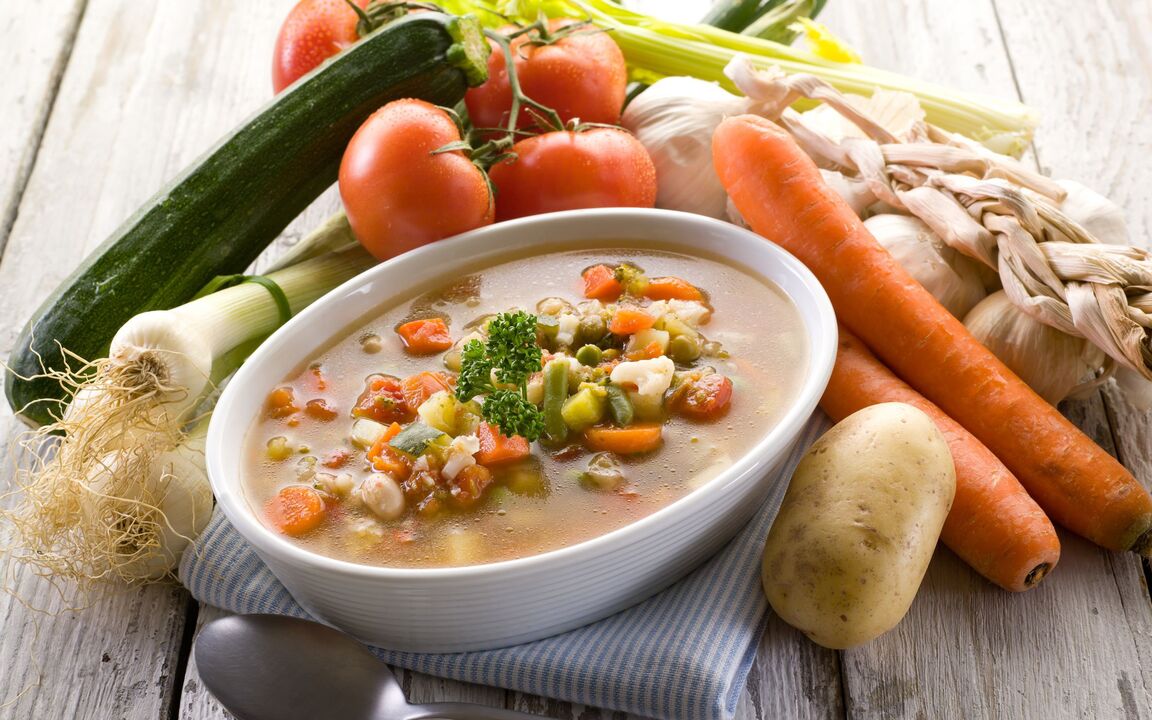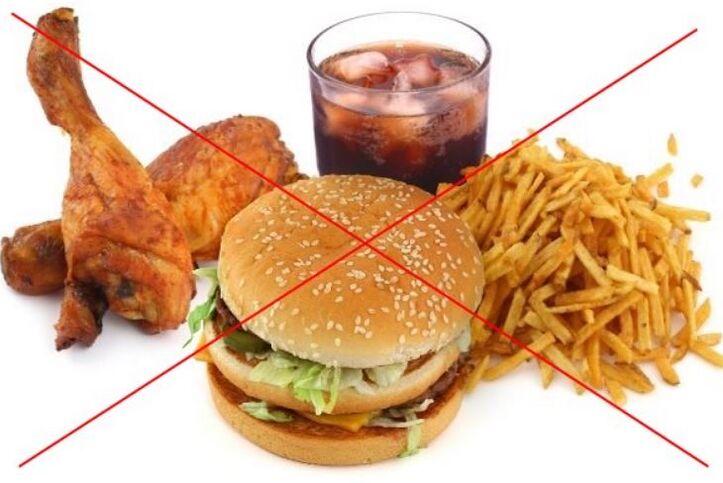Gastritis is one of the most common diseases of our time. Frequent snacks and meals on the run, a variety of fast food, poor-quality food poisoning - all this can cause gastritis. Perhaps that is why many people suffer from stomach problems these days. But how to deal with them?
It is not at all necessary to take medicines continuously, the most important thing in the treatment is a correct and well-chosen diet, which does not cause irritation of the mucous membrane and aggravation of the disease, and at the same time saturates the body with all the necessary macronutrients and vitamins.

General nutritional rules
- Try to eat 5-6 small meals a day. You shouldn't feel hungry. Make it 3 full meals: breakfast, lunch and dinner, as well as small snacks.
- The basis of the diet should be liquid or grated food.
- Choose foods that provide the most benefits: cereals, soups, fish, meat, eggs, cottage cheese, milk and milk products, whole grain or rye bread, fruits, vegetables and berries.
- Pay attention to expiration dates. Give preference to natural foods that have undergone minimal processing. It is better to choose yogurt with a shelf life of one week than with a shelf life of six months.
- Eat as many calories as you need, which can be easily calculated using special programs on the Internet.
- Proteins (meat and fish, cottage cheese, cheese, milk, eggs), fats (vegetables and butter, cheese, egg yolks, nuts), carbohydrates (cereals, pasta, fruits, dried fruits) must be present in the diet every day.
- Steam, cook in a slow cooker or bake in the oven. Another way to cook on the grill without oil.
Important!Drink 1-2 liters of clean water daily. This is the main nutritional recommendation not only for people with gastritis, but also for healthy people.
List of prohibited products
Eating foods that irritate the stomach walls is contraindicated with this disease. It is also worth minimizing the consumption of foods that cause abundant gastric juice production. Such products include:
- fried and smoked foods;
- chips and crackers;
- foods cooked in large amounts of oil;
- purchased sweets;
- ice cream pop;
- wheat flour products;
- lemonade and soda;
- packaged fruit juices;
- mayonnaise, ketchup and purchased sauces;
- alcohol;
- fast food;
- sour berries and fruits;
- sour cottage cheese;
- strong coffee and tea;
- pickled and pickled vegetables;
- low-fat dairy products;
- spicy food;
- pooch;
- conserve;
- meat or fish in its own juice.

Although this list looks quite impressive, eating healthy and tasty is very simple. Note that many products are interchangeable. For example, instead of unhealthy mayonnaise, you can make homemade sauce from natural yogurt, eggs and sunflower oil. It is easy to replace purchased sweets with cheesecakes, honey, fruits and dried fruits, sugar-free jams or nuts. So there is always a possibility of exchange.
Prohibited food additives
It is important to understand that the same product from different manufacturers can have a completely different composition. But it depends on the composition whether you can eat this or that food. So always pay attention to it. Special attention should be paid to these ingredients:
- E-104, E-102 - contribute to the occurrence of diseases of the gastrointestinal tract;
- E-122, E-123 - negatively affects digestion;
- E-150, E-151 - interfere with the normal digestion process of food;
- E-220 - E-226 - causes pain in the stomach;
- E-322 - irritates the stomach wall.
Of course, these are not all additives that have a negative effect on our health. Therefore, always try to choose natural products without unnecessary preservatives.
List of permitted foods
After reading the list of prohibited foods, you may get the impression that there is almost no variety in foods. In fact, this is far from the case. You can eat deliciously and healthily by focusing on the following foods:
- liquid cereals cooked in water or milk;
- vegetable soups with the addition of cereals;
- pureed soup;
- medium or high fat milk or cream;
- scrambled eggs, boiled eggs or soft-boiled eggs;
- vegetable and fruit puree;
- boiled, fried or steamed fish or meat;
- honey, marshmallows, marshmallows, natural jam;
- small amounts of sugar in tea or coffee;
- vegetables and butter;
- pasta and rice;
- greens;
- fresh vegetables, fruits and berries;
- cottage cheese with an average fat content;
- steamed dried fruits;
- jam or marmalade;
- gel;
- weakly brewed tea or coffee;
- cheese;
- mineral water from which gas was previously released;
- freshly squeezed fruit juice, diluted by half with water;
- sour cream or homemade sauce.
A dietary option for a week with a chronic course of the disease
This menu option is an example of the normal course of the disease, without complications and exacerbations. The amount of food is not described in grams, as it varies from person to person and mainly depends on gender, age, weight and height, as well as physical activity. Try to eat little and don't stay hungry.
| Breakfast | Snack | Dinner | Snack | Dinner | |
|---|---|---|---|---|---|
| Monday | Rice porridge cooked in milk, whole grain bread and cheese sandwich, green tea | Apple | Fried cod + pasta | Fresh cabbage and carrot salad | Cottage cheese casserole, tomato-cucumber salad, tea |
| Tuesday | Oatmeal cooked in milk, soft eggs, marshmallows, weak coffee with milk | Banana | Vegetable and rice soup, puree + steamed chicken fillet | A small amount of almonds | Salad of seasonal vegetables + boiled fish |
| Wednesday | Omelet, banana, coffee with milk | Syrniki | Pumpkin puree soup, fried chicken breast | Pine nuts + natural yogurt | Steamed fish + fresh vegetable salad |
| Thursday | Buckwheat porridge with milk, apple and tea | cottage cheese 5% | Soup with pasta, boiled chicken + cucumber and green salad | Kefir | Rice + steamed fish |
| Friday | Omelet, marshmallows, coffee with milk | Cheesecake + natural jam | Vegetable soup, grilled fish + buckwheat | Banana | Boiled potatoes + vegetable salad |
| Saturday | Rice porridge, nuts, a spoonful of jam, coffee with milk | Peaches, nectarines or berries | Macaroni + fried chicken fillet + cheese | Lozenge + tea | Steamed cabbage with carrots + steamed fish |
| Sunday | Corn porridge, marshmallows, tea | Apple | Vegetable soup, rye bread, fried fish | Berries | Omelet + vegetable salad |
Attention!There are also several types of gastritis. And when compiling the menu, you should not forget about them.
The diet of a person with gastritis with low acidity
A decrease in acidity means that it is difficult for the body to produce hydrochloric acid. So your diet should support this. Focus on mashed potatoes, liquid cereals, pasta, cooked meat and fish. Be sure to include boiled eggs, vegetable salad, freshly squeezed fruit juice, baked and fresh fruits, slightly stale bread or homemade biscuits in your diet. The diet should be based on a variety of vegetable dishes. Better to start eating with them. You can add small amounts of spices such as cinnamon, turmeric or coriander to your food.
But fatty meat, legumes, beans, kvass, unripe fruits, carbonated drinks and fresh bread should be avoided.
Diet for gastritis with high acidity
The main purpose of such a diet is directly opposite to the previous one. You need to stimulate the production of hydrochloric acid in every possible way. For this, eat more cereals, soups, fresh vegetables, sweet fruits and compotes made from them, legumes, beans, zucchini, fresh bread. Avoid spicy and fried foods, spices, condiments, pickled and canned vegetables, sour fruits.
What diet should be followed with exacerbation of gastritis?
If the illness suddenly worsens, let your stomach rest. On the first day, it is better not to eat at all, but to drink a lot of water. Not only water is perfect for this purpose, but also decoctions of wild rose, chamomile, weak tea with a small amount of sugar.
Stick to a stricter diet for the next few days. The basis of the diet is soups made from cereals and vegetables, vegetable puree soups. To this, add liquid porridge cooked in milk and boiled fish or chicken. Ideally, all the dishes should be passed through a meat grinder or blender. You can also eat soft-boiled eggs and cottage cheese casserole from the non-acidic cottage cheese.
But fruits, vegetables, dairy products, cheese, cottage cheese, bread and sweets should be avoided during exacerbations.
A diet for gastritis can be not only useful, but also tasty. The point is to show more imagination and come up with interesting recipes. In addition, such nutrition positively affects your figure, skin and general well-being. And the disease will soon recede because you eat correctly and in a balanced way.






























